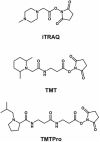Recent advances in isobaric labeling and applications in quantitative proteomics
- PMID: 35687565
- PMCID: PMC9787039
- DOI: 10.1002/pmic.202100256
Recent advances in isobaric labeling and applications in quantitative proteomics
Abstract
Mass spectrometry (MS) has emerged at the forefront of quantitative proteomic techniques. Liquid chromatography-mass spectrometry (LC-MS) can be used to determine abundances of proteins and peptides in complex biological samples. Several methods have been developed and adapted for accurate quantification based on chemical isotopic labeling. Among various chemical isotopic labeling techniques, isobaric tagging approaches rely on the analysis of peptides from MS2-based quantification rather than MS1-based quantification. In this review, we will provide an overview of several isobaric tags along with some recent developments including complementary ion tags, improvements in sensitive quantitation of analytes with lower abundance, strategies to increase multiplexing capabilities, and targeted analysis strategies. We will also discuss limitations of isobaric tags and approaches to alleviate these restrictions through bioinformatic tools and data acquisition methods. This review will highlight several applications of isobaric tags, including biomarker discovery and validation, thermal proteome profiling, cross-linking for structural investigations, single-cell analysis, top-down proteomics, along with applications to different molecules including neuropeptides, glycans, metabolites, and lipids, while providing considerations and evaluations to each application.
Keywords: isobaric tags; isotopic labeling; mass spectrometry; protein quantitation; quantitative proteomics; systems biology.
© 2022 The Authors. Proteomics published by Wiley-VCH GmbH.
Conflict of interest statement
The authors declare no conflict of interest.
Figures







Similar articles
-
Global combined precursor isotopic labeling and isobaric tagging (cPILOT) approach with selective MS(3) acquisition.Proteomics. 2013 Nov;13(22):3267-72. doi: 10.1002/pmic.201300198. Epub 2013 Oct 20. Proteomics. 2013. PMID: 24124127
-
Trends in the Design of New Isobaric Labeling Reagents for Quantitative Proteomics.Molecules. 2019 Feb 15;24(4):701. doi: 10.3390/molecules24040701. Molecules. 2019. PMID: 30781343 Free PMC article. Review.
-
Isobaric labeling-based relative quantification in shotgun proteomics.J Proteome Res. 2014 Dec 5;13(12):5293-309. doi: 10.1021/pr500880b. Epub 2014 Nov 4. J Proteome Res. 2014. PMID: 25337643 Free PMC article. Review.
-
Large-Scale and Deep Quantitative Proteome Profiling Using Isobaric Labeling Coupled with Two-Dimensional LC-MS/MS.Methods Mol Biol. 2016;1410:237-47. doi: 10.1007/978-1-4939-3524-6_14. Methods Mol Biol. 2016. PMID: 26867748 Free PMC article.
-
Quantitative Proteomics Using Isobaric Labeling: A Practical Guide.Genomics Proteomics Bioinformatics. 2021 Oct;19(5):689-706. doi: 10.1016/j.gpb.2021.08.012. Epub 2022 Jan 8. Genomics Proteomics Bioinformatics. 2021. PMID: 35007772 Free PMC article. Review.
Cited by
-
Editorial: The application of OMICS technologies to interrogate host-virus interactions.Front Cell Infect Microbiol. 2022 Nov 14;12:1050012. doi: 10.3389/fcimb.2022.1050012. eCollection 2022. Front Cell Infect Microbiol. 2022. PMID: 36452297 Free PMC article. No abstract available.
-
Advancements in Global Phosphoproteomics Profiling: Overcoming Challenges in Sensitivity and Quantification.Proteomics. 2025 Jan;25(1-2):e202400087. doi: 10.1002/pmic.202400087. Epub 2024 Dec 18. Proteomics. 2025. PMID: 39696887 Free PMC article. Review.
-
Relative quantification of proteins and post-translational modifications in proteomic experiments with shared peptides: a weight-based approach.Bioinformatics. 2025 Mar 4;41(3):btaf046. doi: 10.1093/bioinformatics/btaf046. Bioinformatics. 2025. PMID: 39888862 Free PMC article.
-
Recent Advances in Proteomics-Based Approaches to Studying Age-Related Macular Degeneration: A Systematic Review.Int J Mol Sci. 2022 Nov 25;23(23):14759. doi: 10.3390/ijms232314759. Int J Mol Sci. 2022. PMID: 36499086 Free PMC article.
-
Mass Spectrometry-Based Proteomic Technology and Its Application to Study Skeletal Muscle Cell Biology.Cells. 2023 Nov 1;12(21):2560. doi: 10.3390/cells12212560. Cells. 2023. PMID: 37947638 Free PMC article. Review.
References
-
- Asara, J. M. , Christofk, H. R. , Freimark, L. M. , & Cantley, L. C. (2008). A label‐free quantification method by MS/MS TIC compared to SILAC and spectral counting in a proteomics screen. Proteomics, 8, 994–999. - PubMed
-
- Bondarenko, P. V. , Chelius, D. , & Shaler, T. A. (2002). Identification and relative quantitation of protein mixtures by enzymatic digestion followed by capillary reversed‐phase liquid chromatography−tandem mass spectrometry. Analytical Chemistry, 74(18), 4741–4749. - PubMed
-
- Gygi, S. P. , Rist, B. , Gerber, S. A. , Turecek, F. , Gelb, M. H. , & Aebersold, R. (1999). Quantitative analysis of complex protein mixtures using isotope‐coded affinity tags, Nature Biotechnology, 17, 994–999. - PubMed
Publication types
MeSH terms
Substances
Grants and funding
LinkOut - more resources
Full Text Sources

